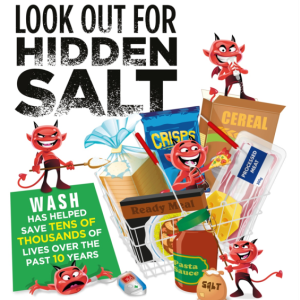
In 2016 the emphasis of World Salt Awareness Week was on hidden salt. How well are you monitoring your salt intake?
This is the salt in our foods that we don’t see or even taste, but that still contributes to our total salt intake. To help the public evaluate their salt intake,Heart and Stroke Foundation South Africa (HSFSA) and Unilever South Africa will also introduce a first in SA – a digital salt calculator.
Salt and health
The World Health Organisation (WHO) recommends a daily salt limit of 5 grams per day (about one teaspoon).
In a 2011 South African study more than half of adults exceeded 10 grams salt a day, at least doubling this recommendation (1). The main consequence of excessive salt intake is raised blood pressure, which in turn leads to heart diseases and strokes. In fact the WHO regards raised blood pressure as the single biggest contributor to heart diseases worldwide (2).
Read: 10 salty food culprits
Given that a devastating 1 in every 3 adults in South Africa suffers from high blood pressure, a reduction in salt intake is an easy win to prevent high blood pressure, improve existing high blood pressure, and thereby reduce the 220 fatalities from heart disease and strokes every day.
Salt and our food
The food we buy already contains salt. In fact 55% of the salt we consume is from salt added during the manufacturing process. Often we cannot see the salt, neither can we taste it – hence the term hidden salt. In higher-income communities the contribution of hidden salt can be as high as 75% of total salt intake (3).
Hidden salt includes much more than potato chips, take-outs and boerewors. Foods such as breakfast cereals, breads, ready-made meals, sauces, spreads, cheeses and processed meats all contain hidden salts and can increase salt intake considerably.
Read: Shake your salt habit
Reducing salt intake requires two broad approaches: reduce salt added to food during manufacturing, and reduce the excessive use of salt and salty products at home.
Salt legislation is around the corner
In 2013 Health Minister Aaron Motsoaledi signed progressive legislation to reduce the salt content of a range of highly salted foods in South Africa. June 2016 is the first deadline for this stepwise reduction programme. With only 3 months to go, all eyes will be on South Africa as the first country to legislate such a wide range of foods. Early indications suggest that industry is making excellent progress towards it.
Is salt legislation enough?
On its own legislation will reduce per capita salt intake by 0.85 g per day. Whilst this is enough to start a shift in cardiovascular mortality, much more is needed (4). The next step is to empower consumers to buy lower salt options and use less salt at home.
Empowering South Africans to know their salt intake
When 1 000 South Africans were asked whether they believed they eat too much salt, 83% said no. Yet the study results further showed that 75% in reality consumed excessive salt (5). Hidden salt is the main reason for this discrepancy, as salt you cannot taste or see is not fully accounted for.
The HSFSA in partnership with Unilever South Africa is introducing a new salt calculator to help South Africans evaluate their salt intake to start making better food choices. The salt calculator estimates salt intake based on the frequency by which common foods are consumed, and then provides feedback on current intake and tips on making better food choices.
Read: Salt: the slow, silent killer
Hlanzeka Mpanza, dietitian at Unilever says “Only when you know which particular foods in your diet contributes the most to your total intake, can you effectively cut down on hidden salt. You can start to choose lower salt options by comparing products."
HSFSA encourages members of the public to use the new salt calculator to measure their salt intake, and to start making changes. The equation is simple: check your salt – change your salt.
The salt calculator will go live on Monday 29 February at www.saltcalculator.co.za
A final word: Are food manufacturers worth their salt?
HSFSA would like to congratulate manufacturers that are on course to reduce the salt content of products to comply with legislation. “Salt legislation is the beginning and not the ending. We encourage food manufacturers as well as the restaurant industry to continue adapting their recipes to provide South Africans with healthier foods," says Dr Vash Mungal-Singh, CEO of the HSFSA.
Read: South Africans consume too much salt
Use #LessSaltPlease to join the conversation on twitter.
About the Heart and Stroke Foundation SA
The Heart and Stroke Foundation South Africa (HSFSA) plays a leading role in the fight against preventable heart disease and stroke, with the aim of seeing fewer people in South Africa suffer premature deaths and disabilities. The HSF, established in 1980 is a non-governmental, non-profit organisation.
The HSFSA aims to reduce the cardiovascular disease (CVD) burden in South Africa and ultimately on the health care system of South Africa. Our mission is to empower people in South Africa to adopt healthy lifestyles, make healthy choices easier, seek appropriate care and encourage prevention.
Read: Healthy lifestyle fights ageing
The Heart and Stroke Foundation (HSF) is the implementing body of the Salt Watch campaign, a national public awareness and education campaign to encourage South Africans to reduce their salt intake.
Salt Watch is driven by a multisectoral coalition, supported by the National Department of Health, and is a member of World Action on Salt and Health.
Read more:
Small cuts in salt intake spur big drops in heart trouble
New diet guidelines advise less salt
References:
1. Lategan R. The association of body weight, 25-hydroxyvitamin D, sodium intake, physical activity levels and genetic factors with the prevalence of hypertension in a low income, black urban community in Mangaung, Free State, South Africa. [PhD thesis]. Bloemfontein: University of the Free State; 2011.
2. World Health Organization. Global Health Risks: Mortality and Burden of Disease Attributable to Selected Major Risks. Geneva: World Health Organization 2009.
3. Mattes RD, Donnelly D. Relative contributions of dietary sodium sources. J Am Coll Nutr. 1991;10(4):383-393.
4. Bertram, et al. Reducing the sodium content of high-salt foods: Effect on cardiovascular disease in South Africa. South African Medical Journal 2012; 102(9): 743-745.
5. Newson et al. Barriers for progress in salt reduction in the general population. An international study. Appetite 2013; 71:22-31.




 Publications
Publications
 Partners
Partners














